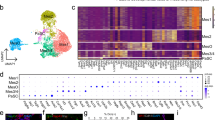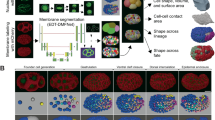Abstract
The determinants of vertebrate organ size are poorly understood, but the process is thought to depend heavily on growth factors and other environmental cues. In the blood and central nervous system, for example, organ mass is determined primarily by growth-factor-regulated cell proliferation and apoptosis to achieve a final target size. Here, we report that the size of the mouse pancreas is constrained by an intrinsic programme established early in development, one that is essentially not subject to growth compensation. Specifically, final pancreas size is limited by the size of the progenitor cell pool that is set aside in the developing pancreatic bud. By contrast, the size of the liver is not constrained by reductions in the progenitor cell pool. These findings show that progenitor cell number, independently of regulation by growth factors, can be a key determinant of organ size.
This is a preview of subscription content, access via your institution
Access options
Subscribe to this journal
Receive 51 print issues and online access
$199.00 per year
only $3.90 per issue
Buy this article
- Purchase on SpringerLink
- Instant access to full article PDF
Prices may be subject to local taxes which are calculated during checkout






Similar content being viewed by others
References
Gilbert, S. F. Developmental Biology (Sinauer, Sunderland, Massachusetts, 2000)
Bryant, P. J. & Simpson, P. Intrinsic and extrinsic control of growth in developing organs. Q. Rev. Biol. 59, 387–415 (1984)
Conlon, I. & Raff, M. Size control in animal development. Cell 96, 235–244 (1999)
Britton, J. S., Lockwood, W. K., Li, L., Cohen, S. M. & Edgar, B. A. Drosophila’s insulin/PI3-kinase pathway coordinates cellular metabolism with nutritional conditions. Dev. Cell 2, 239–249 (2002)
Rulifson, E. J., Kim, S. K. & Nusse, R. Ablation of insulin-producing neurons in flies: growth and diabetic phenotypes. Science 296, 1118–1120 (2002)
Ikeya, T., Galic, M., Belawat, P., Nairz, K. & Hafen, E. Nutrient-dependent expression of insulin-like peptides from neuroendocrine cells in the CNS contributes to growth regulation in Drosophila. Curr. Biol. 12, 1293–1300 (2002)
Colombani, J. et al. Antagonistic actions of ecdysone and insulins determine final size in Drosophila. Science 310, 667–670 (2005)
Twitty, V. C. & Schwind, J. L. The growth of eyes and limbs transplanted heteroplastically between two species of Ambystoma. J. Exp. Zool. 59, 61–86 (1931)
Wolpert, L. Cellular basis of skeletal growth during development. Br. Med. Bull. 37, 215–219 (1981)
Muller-Sieburg, C. E., Cho, R. H., Sieburg, H. B., Kupriyanov, S. & Riblet, R. Genetic control of hematopoietic stem cell frequency in mice is mostly cell autonomous. Blood 95, 2446–2448 (2000)
Robin, C. et al. An unexpected role for IL-3 in the embryonic development of hematopoietic stem cells. Dev. Cell 11, 171–180 (2006)
Gu, G., Dubauskaite, J. & Melton, D. A. Direct evidence for the pancreatic lineage: NGN3+ cells are islet progenitors and are distinct from duct progenitors. Development 129, 2447–2457 (2002)
Holland, A. M., Hale, M. A., Kagami, H., Hammer, R. E. & MacDonald, R. J. Experimental control of pancreatic development and maintenance. Proc. Natl Acad. Sci. USA 99, 12236–12241 (2002)
Lee, P. et al. Conditional lineage ablation to model human diseases. Proc. Natl Acad. Sci. USA 95, 11371–11376 (1998)
Kistner, A. et al. Doxycycline-mediated quantitative and tissue-specific control of gene expression in transgenic mice. Proc. Natl Acad. Sci. USA 93, 10933–10938 (1996)
Guz, Y. et al. Expression of murine STF-1, a putative insulin gene transcription factor, in beta cells of pancreas, duodenal epithelium and pancreatic exocrine and endocrine progenitors during ontogeny. Development 121, 11–18 (1995)
Jonsson, J., Carlsson, L., Edlund, T. & Edlund, H. Insulin-promoter-factor 1 is required for pancreas development in mice. Nature 371, 606–609 (1994)
Offield, M. F. et al. PDX-1 is required for pancreatic outgrowth and differentiation of the rostral duodenum. Development 122, 983–995 (1996)
Ahlgren, U., Jonsson, J. & Edlund, H. The morphogenesis of the pancreatic mesenchyme is uncoupled from that of the pancreatic epithelium in IPF1/PDX1-deficient mice. Development 122, 1409–1416 (1996)
Chen, J., Lansford, R., Stewart, V., Young, F. & Alt, F. W. RAG-2-deficient blastocyst complementation: an assay of gene function in lymphocyte development. Proc. Natl Acad. Sci. USA 90, 4528–4532 (1993)
Liegeois, N. J., Horner, J. W. & DePinho, R. A. Lens complementation system for the genetic analysis of growth, differentiation, and apoptosis in vivo. Proc. Natl Acad. Sci. USA 93, 1303–1307 (1996)
Hadjantonakis, A. K., Macmaster, S. & Nagy, A. Embryonic stem cells and mice expressing different GFP variants for multiple non-invasive reporter usage within a single animal. BMC Biotechnol. 2, 11 (2002)
Wang, Z. & Jaenisch, R. At most three ES cells contribute to the somatic lineages of chimeric mice and of mice produced by ES-tetraploid complementation. Dev. Biol. 275, 192–201 (2004)
Deutsch, G., Jung, J., Zheng, M., Lora, J. & Zaret, K. S. A bipotential precursor population for pancreas and liver within the embryonic endoderm. Development 128, 871–881 (2001)
Taub, R. Liver regeneration: from myth to mechanism. Nature Rev. Mol. Cell Biol. 5, 836–847 (2004)
Westmacott, A., Burke, Z. D., Oliver, G., Slack, J. M. & Tosh, D. C/EBPα and C/EBPβ are markers of early liver development. Int. J. Dev. Biol. 50, 653–657 (2006)
Lavon, I. et al. High susceptibility to bacterial infection, but no liver dysfunction, in mice compromised for hepatocyte NF-κB activation. Nature Med. 6, 573–577 (2000)
Furth, P. A. et al. Temporal control of gene expression in transgenic mice by a tetracycline-responsive promoter. Proc. Natl Acad. Sci. USA 91, 9302–9306 (1994)
Kalthoff, K. Analysis of Biological Development (McGraw-Hill, New York, 1996)
Gallant, P. Myc, cell competition, and compensatory proliferation. Cancer Res. 65, 6485–6487 (2005)
Hidalgo, A. & ffrench-Constant, C. The control of cell number during central nervous system development in flies and mice. Mech. Dev. 120, 1311–1325 (2003)
Morrison, S. J., Uchida, N. & Weissman, I. L. The biology of hematopoietic stem cells. Annu. Rev. Cell Dev. Biol. 11, 35–71 (1995)
Bort, R., Signore, M., Tremblay, K., Martinez Barbera, J. P. & Zaret, K. S. Hex homeobox gene controls the transition of the endoderm to a pseudostratified, cell emergent epithelium for liver bud development. Dev. Biol. 290, 44–56 (2006)
Bhushan, A. et al. Fgf10 is essential for maintaining the proliferative capacity of epithelial progenitor cells during early pancreatic organogenesis. Development 128, 5109–5117 (2001)
Norgaard, G. A., Jensen, J. N. & Jensen, J. FGF10 signaling maintains the pancreatic progenitor cell state revealing a novel role of Notch in organ development. Dev. Biol. 264, 323–338 (2003)
Hart, A., Papadopoulou, S. & Edlund, H. Fgf10 maintains notch activation, stimulates proliferation, and blocks differentiation of pancreatic epithelial cells. Dev. Dyn. 228, 185–193 (2003)
Papadopoulou, S. & Edlund, H. Attenuated Wnt signaling perturbs pancreatic growth but not pancreatic function. Diabetes 54, 2844–2851 (2005)
Murtaugh, L. C., Law, A. C., Dor, Y. & Melton, D. A. β-catenin is essential for pancreatic acinar but not islet development. Development 132, 4663–4674 (2005)
Heiser, P. W., Lau, J., Taketo, M. M., Herrera, P. L. & Hebrok, M. Stabilization of β-catenin impacts pancreas growth. Development 133, 2023–2032 (2006)
Temple, S. & Raff, M. C. Clonal analysis of oligodendrocyte development in culture: evidence for a developmental clock that counts cell divisions. Cell 44, 773–779 (1986)
Weissman, I. L., Anderson, D. J. & Gage, F. Stem and progenitor cells: origins, phenotypes, lineage commitments, and transdifferentiations. Annu. Rev. Cell Dev. Biol. 17, 387–403 (2001)
Dor, Y., Brown, J., Martinez, O. I. & Melton, D. A. Adult pancreatic β-cells are formed by self-duplication rather than stem-cell differentiation. Nature 429, 41–46 (2004)
Acknowledgements
We thank R. MacDonald, R. DePinho, G. Fishman, H. Bujard and C. Wright for sharing mouse strains, C. Wright for sharing antibodies, and A. Nagy for providing ES cells. We also thank M. Stolovich-Rein and Y. Dor for assistance in quantifying chimaerism, A. Greenwood for assistance with pancreatic lineage quantification, and A. Panikkar for assistance with morphometric analysis. We are grateful to J. Rajagopal, D. Huangfu, Y. Dor and Q. Zhou for critically reading the manuscript, and to S. Snapper, K. Eggan and H. Akutsu for suggestions and technical expertise. L. Peeples and J. Zhang provided assistance with the statistical analysis. B.Z.S. is supported by an award from NIDDK. D.A.M. is an investigator of the Howard Hughes Medical Institute.
Author information
Authors and Affiliations
Corresponding authors
Ethics declarations
Competing interests
Reprints and permissions information is available at www.nature.com/reprints. The authors declare no competing financial interests.
Supplementary information
Supplementary Information
This file contains Supplementary Methods, Supplementary Figures 1-7 with Legends, Supplementary Table 1 and additional references. (PDF 1650 kb)
Rights and permissions
About this article
Cite this article
Stanger, B., Tanaka, A. & Melton, D. Organ size is limited by the number of embryonic progenitor cells in the pancreas but not the liver. Nature 445, 886–891 (2007). https://doi.org/10.1038/nature05537
Received:
Accepted:
Published:
Issue Date:
DOI: https://doi.org/10.1038/nature05537



